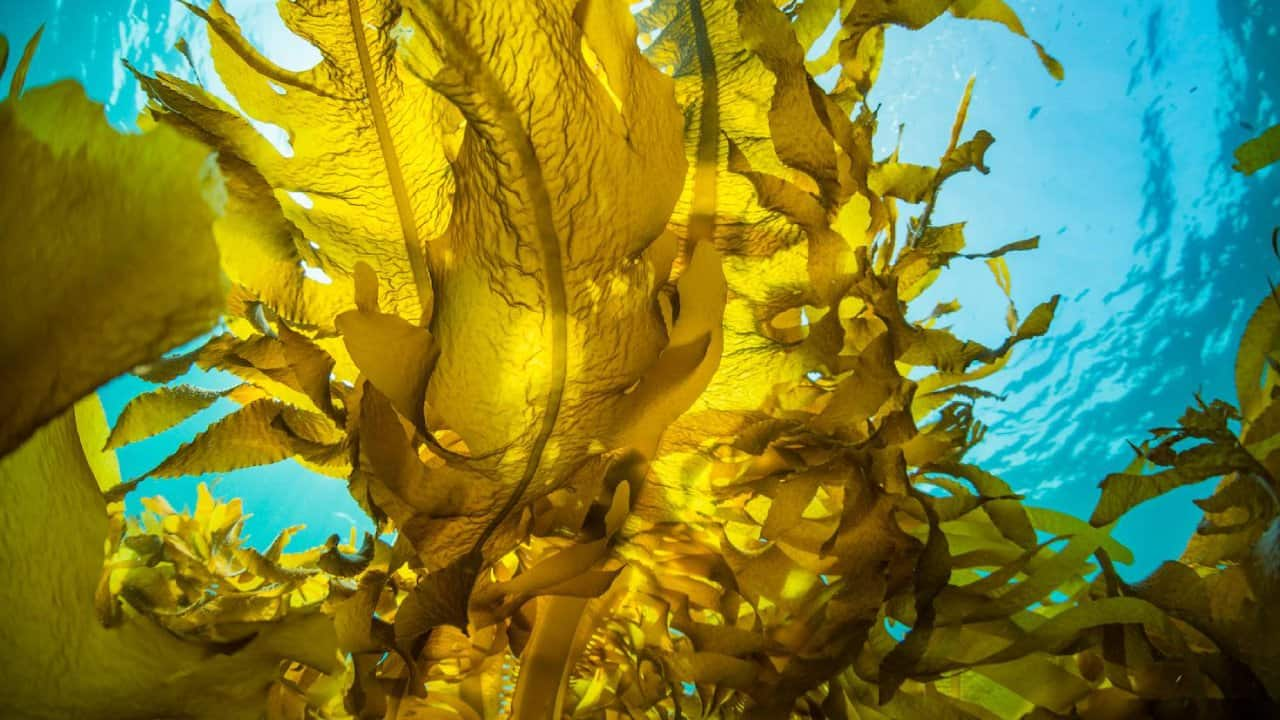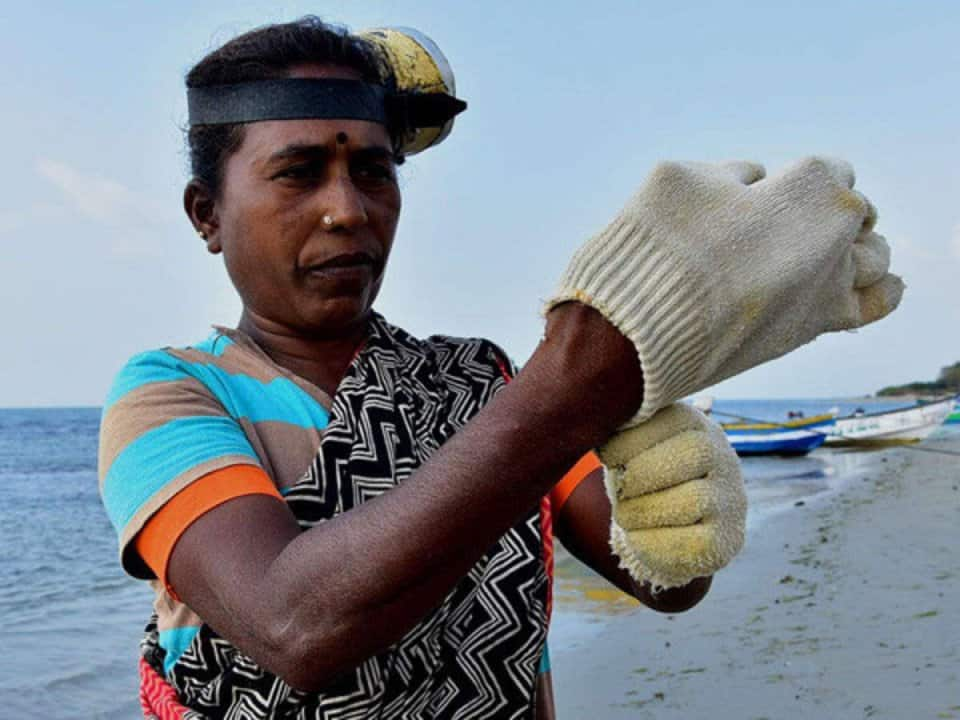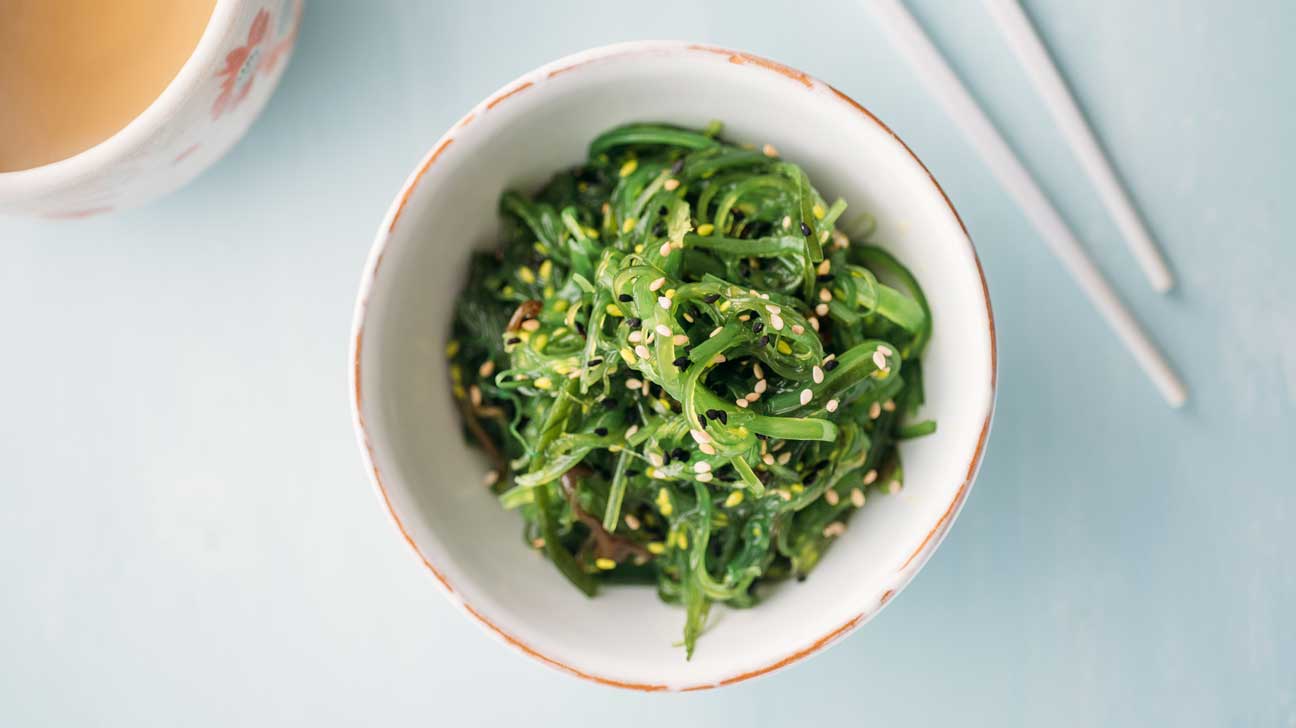


![Gabrielle D'cruz, founder of The Good Ocean; a woman diver of Tamil Nadu; and Pamban, between peninsular India and Sri Lanka, has over 4,000 species of marine plants and animals. (Photos courtesy [L to R]: The Good Ocean; UNDP; and The Good Ocean)](https://images.moneycontrol.com/static-mcnews/2023/06/seaweed-diver-1-770x433.jpg?impolicy=website&width=770&height=431)
For the indomitable women who power the buzzing seaweed industry in Tamil Nadu, the workplace is a short walk away from home — at ocean-fronted sites like the coastline of Bharathinagar, in the Thiruppullani block, in Pemban. For five months a year, wearing a T-shirt over their saris, the women walk up to the shore, take their boats to waters a few feet deep, and dive in to harvest seaweed that once grew wild here, but is now being harvested in specific sites.
Seaweed, used in industries such as pharma, beauty, print, and processed foods, is increasingly seen as a sustainable and climate-resistant superfood. Dietician and nutritionist Seema Singh says, “Seaweeds contain bioactive compounds flush with minerals that have antioxidant properties. Several studies have shown that eating seaweed as part of the diet is one of the prime reasons for the low incidence of breast and prostate cancer in Japan and China.”
 A seaweed farm. (Photo: UNDP)
A seaweed farm. (Photo: UNDP)
Sustainable and climate-resistant
Seaweed gets everything it needs from the water around it; there is no need for fertilizers to grow it and no pollution is caused. “They are just very delicate and it requires cutting the leaves at the right time in the plant's lifecycle, which supports speedy re-growth,” says Gabrielle D’cruz, a Goa-based marine conservationist and founder of Indian seaweed food company The Good Ocean.
In pics: Women show the way as India pushes 'eco-miracle' seaweed
Clusters of seaweed utilize atmospheric carbon, act as a good sink for CO2, and contribute towards carbon sequestration, earning their home state and the country precious carbon points, which are crucial bargaining chips in the world economy.
India’s long and biodiversity-rich coastline is home to over 840 species of seaweed, “most of them edible,” says D'cruz. D’cruz, who works with chefs in Goa and Mumbai, among them Chef Varun Totlani of Masque, and Miguel and Makutsu in Goa, adds, “Goa itself has such rich ocean biodiversity, with a variety of fish, crabs and prawns, even during monsoons, that we have overlooked seaweed as food.”
To her, harvesting seaweed seemed like a possible business option after she met and worked with the Tamil Nadu women divers.
 Gabrielle D’cruz of The Good Ocean.
Gabrielle D’cruz of The Good Ocean.
Harvesting seaweed and seaweed farms
Tamil Nadu has dozens of seaweed-harvesting sites and is setting up a multi-crore seaweed park. UNESCO considers Pamban, a diving site positioned between peninsular India and Sri Lanka, as among the world’s richest in biodiversity, with over 4,000 species of marine plants and animals, with a wide variety of seaweed available to be harvested.
Goa has about four or five sites, where D’cruz harvests the Gracilaria and Sargassum varieties in seaweed farms. “We have trained people to harvest the seaweed, which needs delicate handling. They are not pulling it off the rock but picking it carefully,” says D’cruz.
The women of Tamil Nadu do it a bit differently. A.D. Mookupuri, who heads a group of women divers as a sort of unofficial leader, says she has been diving for seaweed since she was 9.
The group of women sets out early morning with their white net bags tied to their waists, in their boats. They wear T-shirts over their saris, underwater goggles, fin-like flippers on their feet and bandages on their hands. They have tried to wear gloves but found them no match for the strong currents, so they just tie bandages. “We are out there till noon…after which sea comes up and we have to leave with the net bags.”
 The divers tried gloves but found them no match for the currents.
The divers tried gloves but found them no match for the currents.
The seas are getting choppier as climate warms and levels rise. Says D’cruz, “It can be dangerous which is why we need experienced harvesters. The rocks are jagged and you can cut your feet on them. Some of the newer harvesters go to the rocks during low tide but the more experienced ones even harvest it during high tide.”
The seaweed divers of Pamban work to the rhythm of the lunar cycle, harvesting seaweed only 12 days a month when the tides are weaker. There are breaks taken between the harvests, to allow it to regenerate. The women, says Mookupuri, earn about Rs 2,000 per week or Rs 10,000-15,000 per month.
 The seaweed divers leaving early in the morning.
The seaweed divers leaving early in the morning.
How to eat seaweed?
While there aren’t too many traditional recipes for seaweed in India’s culinary heritage, in some parts of Kerala seaweed is added to a soup-like meal and in Tamil Nadu, to a leafy vegetable. In Kadmat islands in Lakshadweep, seaweed is either pickled or fried. One of the easiest ways is to fry dried seaweed and add rock salt and your favourite herbs.
 Seaweed and sesame
Seaweed and sesame
D’cruz says one of the exciting experiments with seaweed is being done by Chef Varun at Masque, Mumbai. “He isn’t looking at seaweed as Japanese cuisine would. Instead, he is creating modern Indian dishes with it.” At Masque, the chefs have used dried seaweed on everything, from appetizers to desserts and cocktails.
At Makutsu, the Japanese izakaya run by Chef Pablo Miranda in Goa, you can eat your seaweed with avocado, nori, wasabi and sesame crisp. At Bangalore’s Farmlore, seaweed oil is added to the risotto. At Saga New Delhi, the Sea Tangle and Darjeeling tea leaf recipe has infusions of seaweed.
While every species of seaweed has its colour, texture and flavour, the closest flavour profile is umami, even a bit like the sea. “The best analogy is the taste you are left with when you accidentally gulp a little seawater. It is like having the ocean in your mouth,” says D’cruz.
Discover the latest Business News, Sensex, and Nifty updates. Obtain Personal Finance insights, tax queries, and expert opinions on Moneycontrol or download the Moneycontrol App to stay updated!
Find the best of Al News in one place, specially curated for you every weekend.
Stay on top of the latest tech trends and biggest startup news.